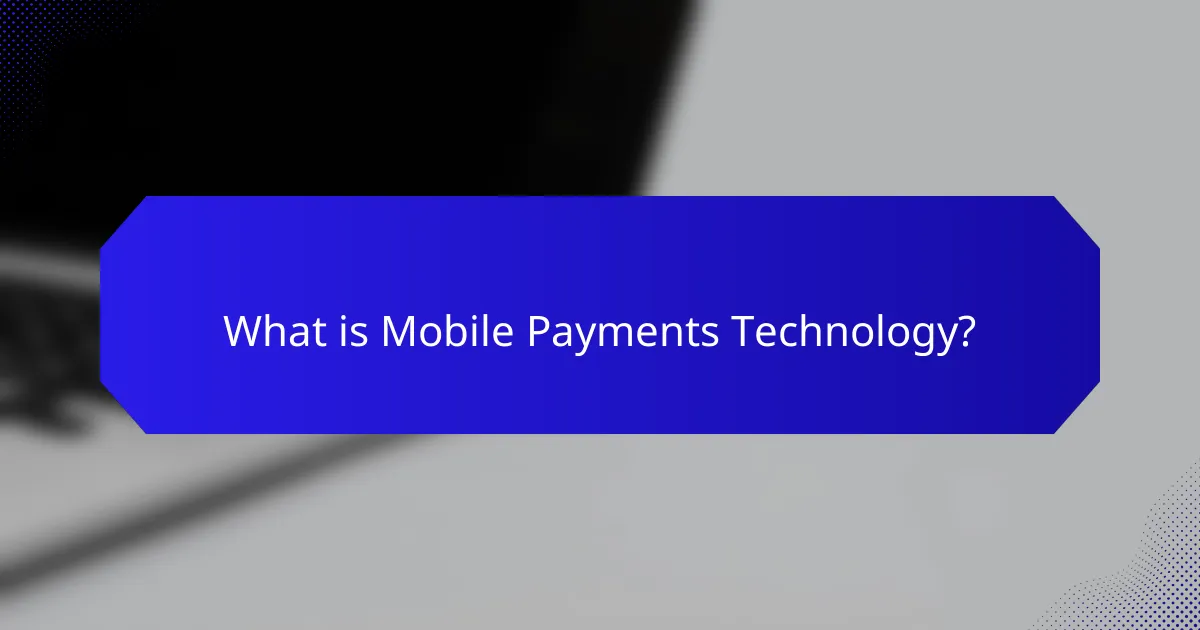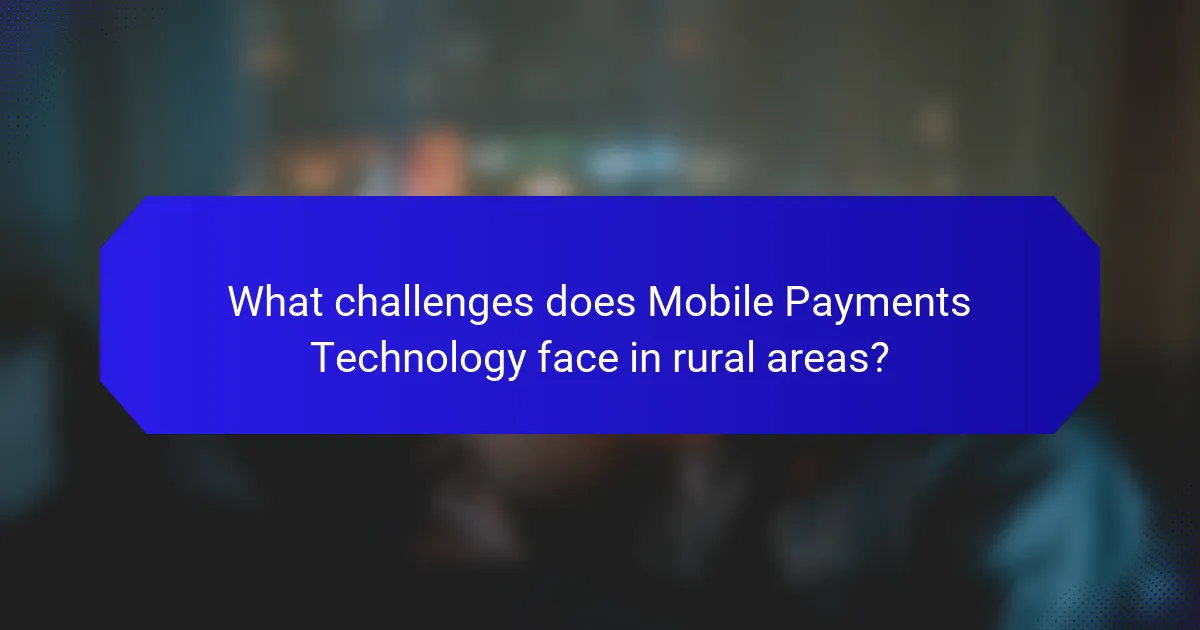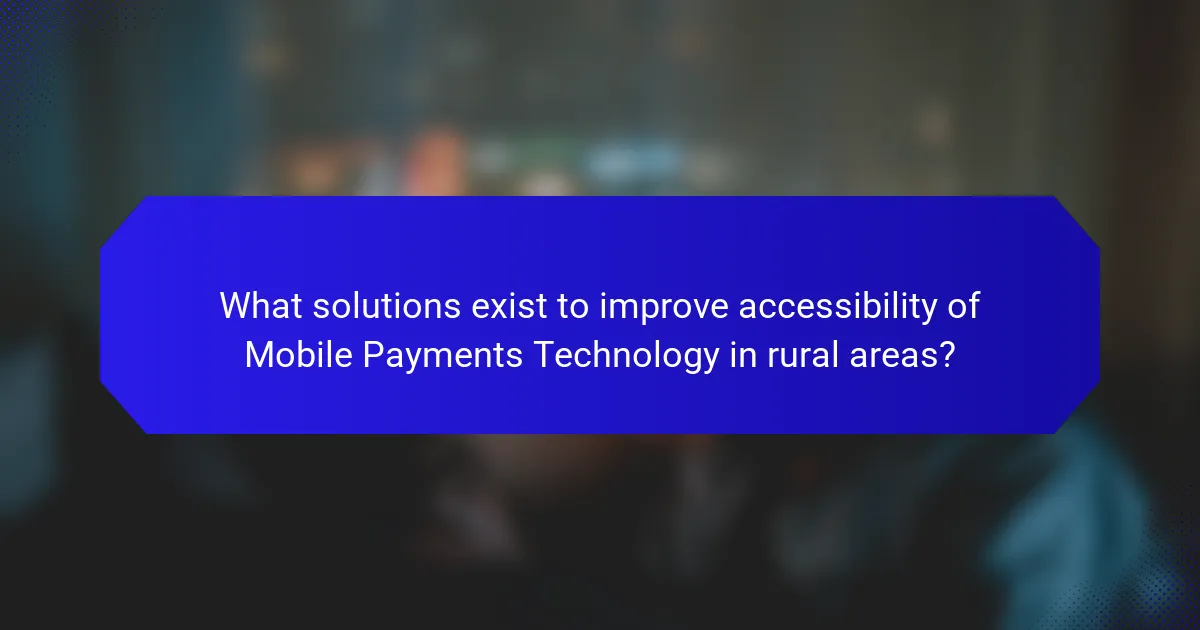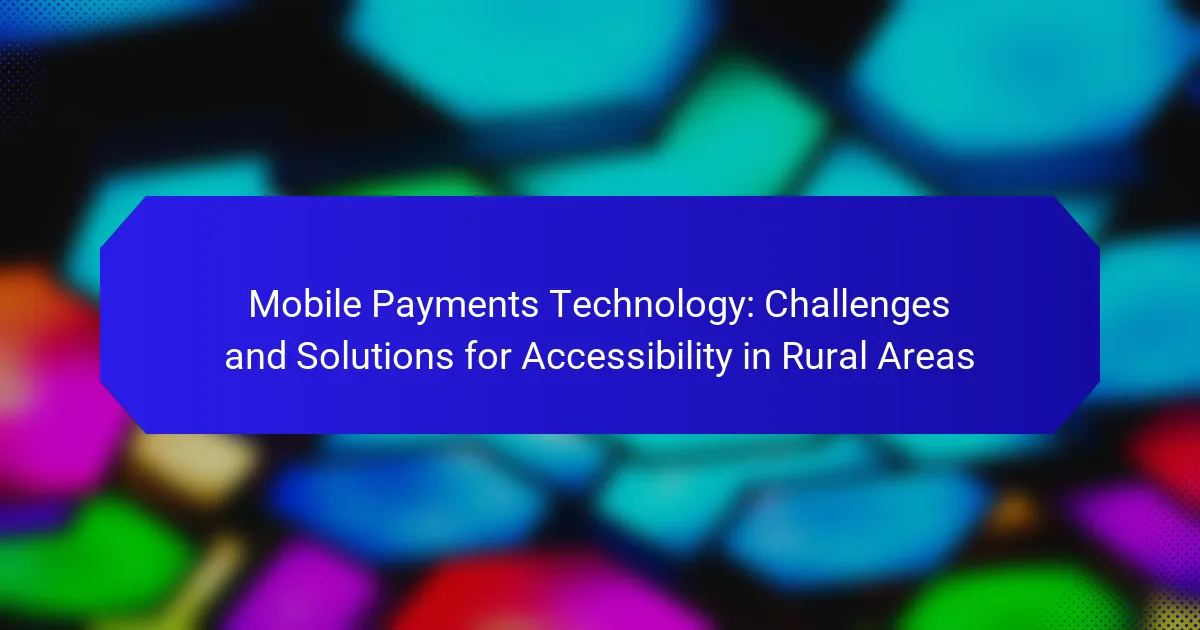Mobile payments technology facilitates financial transactions via mobile devices, enabling users to make purchases, transfer money, and manage accounts through smartphones or tablets. This technology employs methods such as Near Field Communication (NFC), QR codes, and mobile wallets, with a projected transaction value exceeding $12 trillion by 2025, reflecting growing consumer adoption. However, rural areas face challenges such as limited internet connectivity, inadequate infrastructure, low smartphone penetration, and security concerns, which hinder the usability of mobile payments. Solutions to enhance accessibility include improving internet infrastructure, providing affordable mobile devices, implementing financial literacy programs, and promoting merchant acceptance of mobile payment systems.

What is Mobile Payments Technology?
Mobile payments technology enables financial transactions using mobile devices. It allows users to make purchases, transfer money, and manage accounts through smartphones or tablets. This technology utilizes various methods, including Near Field Communication (NFC), QR codes, and mobile wallets. According to a report by Statista, mobile payment transaction value is projected to reach over $12 trillion by 2025. This growth indicates increasing consumer adoption and reliance on mobile payment solutions. Mobile payments enhance convenience and speed, making transactions easier for users. They also provide opportunities for businesses to reach customers in diverse locations, including rural areas.
How does Mobile Payments Technology function?
Mobile payments technology functions by enabling transactions through mobile devices. Users link their bank accounts or credit cards to mobile payment apps. When making a purchase, the user selects the payment app and authorizes the transaction. This can involve entering a PIN or using biometric authentication like fingerprint recognition. The app then communicates with the merchant’s payment system. This communication often uses near-field communication (NFC) or QR codes. The transaction is processed in real time, transferring funds electronically. According to a report by Statista, mobile payment transaction volume is expected to exceed $4.5 trillion by 2023, highlighting its growing adoption.
What are the key components of Mobile Payments Technology?
The key components of mobile payments technology include mobile wallets, payment gateways, and security protocols. Mobile wallets allow users to store payment information on their devices. Payment gateways facilitate the transaction between the customer and the merchant. Security protocols, such as encryption and tokenization, protect sensitive data during transactions. These components work together to enable seamless and secure financial transactions. According to a report by Statista, mobile payment transaction value is expected to reach $6.7 trillion by 2023, highlighting the technology’s growing importance.
How do these components interact to facilitate transactions?
Mobile payments technology components interact through secure data transmission, user authentication, and transaction processing. The mobile device captures payment details and encrypts them for security. This data is sent to a payment gateway, which processes the transaction. User authentication verifies the identity of the payer through methods like biometrics or PINs. Once authenticated, the payment gateway communicates with the bank or financial institution to approve the transaction. The bank confirms the transaction and sends a response back to the gateway. Finally, the payment gateway notifies the mobile device of the transaction status. This interaction ensures secure and efficient transactions in mobile payments.
What are the primary benefits of Mobile Payments Technology?
Mobile payments technology offers convenience, speed, security, and accessibility. Users can make transactions quickly using their smartphones. This eliminates the need for cash or physical cards. Mobile payments also enhance security through encryption and tokenization. According to a report by Statista, global mobile payment transaction value is projected to reach $12.06 trillion by 2026. Additionally, mobile payments increase financial inclusion in rural areas. They allow users without access to traditional banking to participate in the economy. Overall, mobile payments streamline transactions and improve user experience.
How does Mobile Payments Technology enhance user convenience?
Mobile Payments Technology enhances user convenience by enabling quick and seamless transactions. Users can make payments using their smartphones without needing cash or cards. This technology allows for contactless payments, reducing transaction times significantly. According to a study by the Federal Reserve, mobile payments can cut transaction time by up to 50%. Additionally, users can access payment apps anytime and anywhere, providing flexibility. The integration of biometric security features adds a layer of safety, further encouraging usage. Overall, Mobile Payments Technology streamlines the purchasing process and enhances user experience.
What economic advantages does Mobile Payments Technology provide?
Mobile payments technology provides significant economic advantages, including increased transaction speed and reduced operational costs. Transactions completed via mobile payments are typically faster than traditional methods. This speed enhances customer satisfaction and encourages repeat business.
Additionally, mobile payments reduce the need for physical cash handling. This minimizes cash-related risks and costs for businesses. According to a study by McKinsey, businesses adopting mobile payment systems can see a reduction in transaction costs by up to 30%.
Mobile payments also facilitate access to financial services for unbanked populations. This inclusion can stimulate local economies by enabling more people to participate in commerce. As a result, mobile payments can drive economic growth in underserved areas.

What challenges does Mobile Payments Technology face in rural areas?
Mobile payments technology faces significant challenges in rural areas. Limited internet connectivity hampers transaction speed and reliability. Many rural regions have inadequate infrastructure for mobile networks. This results in frequent service interruptions. Low smartphone [censured] also restricts access to mobile payment solutions. Additionally, a lack of digital literacy can hinder user adoption. Security concerns may further discourage individuals from using mobile payment systems. Lastly, limited merchant acceptance of mobile payments reduces overall usability in these areas.
Why is accessibility a concern for Mobile Payments Technology in rural regions?
Accessibility is a concern for Mobile Payments Technology in rural regions due to limited internet connectivity. Many rural areas lack reliable broadband infrastructure. This results in inconsistent access to mobile payment services. Additionally, lower smartphone [censured] in these regions hampers usage. According to the Federal Communications Commission, 23 million Americans lack access to high-speed internet. Furthermore, financial literacy levels may be lower in rural populations. This can lead to challenges in adopting mobile payment technologies. Overall, these factors contribute to significant barriers for mobile payments in rural areas.
What infrastructural limitations hinder Mobile Payments Technology adoption?
Infrastructural limitations hindering mobile payments technology adoption include inadequate internet connectivity, limited access to smartphones, and insufficient payment infrastructure. Many rural areas lack reliable internet access, which is essential for mobile transactions. According to a report by the International Telecommunication Union, approximately 3.7 billion people remain unconnected globally, primarily in rural regions. Additionally, the affordability and availability of smartphones can restrict usage. A study by the Pew Research Center found that smartphone ownership is lower in rural areas compared to urban settings. Furthermore, the absence of point-of-sale systems and merchant acceptance of mobile payments can deter users. A survey by the Federal Reserve indicated that many small businesses in rural areas do not accept mobile payments due to lack of infrastructure. These limitations collectively impede the widespread adoption of mobile payments technology.
How do socio-economic factors affect the usage of Mobile Payments Technology?
Socio-economic factors significantly influence the usage of mobile payments technology. Individuals with higher income levels are more likely to adopt mobile payment solutions. Access to smartphones and reliable internet also correlates with socio-economic status. In rural areas, lower income can limit access to these technologies. Studies show that 60% of urban residents use mobile payments compared to only 30% in rural regions. Education plays a critical role; individuals with higher education levels are more inclined to utilize mobile payments. Cultural attitudes towards technology adoption can also vary by socio-economic background. Overall, these factors create disparities in mobile payment technology usage across different socio-economic groups.
What security concerns are associated with Mobile Payments Technology in rural areas?
Mobile payments technology in rural areas faces several security concerns. Limited internet connectivity increases vulnerability to fraud and cyberattacks. Rural users often lack awareness of security protocols, making them easy targets. Additionally, inadequate infrastructure can lead to data breaches during transactions. The use of outdated devices may not support the latest security updates. According to a 2020 report by the Federal Trade Commission, rural consumers report higher rates of identity theft related to mobile payments. These factors collectively heighten the risks associated with mobile payment systems in these regions.
How can data privacy issues impact user trust in Mobile Payments Technology?
Data privacy issues can significantly impact user trust in mobile payments technology. When users perceive that their personal information is at risk, they are less likely to engage with mobile payment systems. Research indicates that 79% of consumers express concerns about data privacy when using such technologies. This distrust can lead to decreased adoption rates and lower transaction volumes. Furthermore, incidents of data breaches can exacerbate these concerns, as seen in high-profile cases where sensitive information was compromised. Users expect robust security measures to protect their data. If these expectations are not met, trust diminishes. Thus, ensuring data privacy is crucial for fostering user confidence in mobile payments.
What measures can be taken to enhance security for rural users?
Implementing multi-factor authentication enhances security for rural users. This method requires users to provide two or more verification factors to gain access. It reduces the risk of unauthorized access significantly. Regular software updates are essential for protecting against vulnerabilities. Keeping systems current helps mitigate security threats. Educating users about phishing attacks increases awareness. Training rural users can prevent them from falling victim to scams. Utilizing secure payment gateways ensures transactions are encrypted. Encryption protects sensitive data during mobile payments. Lastly, establishing local support networks fosters community safety. Local assistance can help users navigate security challenges effectively.

What solutions exist to improve accessibility of Mobile Payments Technology in rural areas?
Improving accessibility of mobile payments technology in rural areas can be achieved through several solutions. Expanding internet connectivity is crucial. Increased access to reliable mobile networks enables transactions. Partnerships with local governments can facilitate infrastructure development. Offering low-cost mobile devices can make technology more accessible. Financial literacy programs help users understand mobile payment systems. Collaborations with local businesses can promote acceptance of mobile payments. Implementing offline payment options ensures usability in areas with poor connectivity. Finally, user-friendly interfaces can enhance the experience for all users.
How can technology infrastructure be improved to support Mobile Payments?
Technology infrastructure can be improved to support mobile payments by enhancing network coverage and reliability. Expanding 4G and 5G networks in rural areas can facilitate faster and more reliable transactions. Implementing secure payment gateways is essential for protecting user data during transactions. Investing in cloud-based solutions can improve scalability and accessibility for service providers. Increasing interoperability between different payment systems can streamline user experiences. Providing training and resources for local businesses can encourage adoption of mobile payment solutions. Collaborating with local governments can help in developing supportive policies and incentives. Research indicates that improved infrastructure can lead to a 30% increase in mobile payment usage in underserved areas.
What role do local governments play in enhancing Mobile Payments infrastructure?
Local governments play a crucial role in enhancing mobile payments infrastructure. They facilitate the development of policies that support mobile payment systems. Local governments often collaborate with private sector companies to improve technology access. They can provide funding for infrastructure projects that enable mobile payments. Additionally, they promote public awareness and education about mobile payment options. Local governments can also address regulatory challenges that hinder mobile payment adoption. By creating a favorable environment, they encourage innovation in mobile payment solutions. This involvement is essential for increasing accessibility, especially in rural areas.
How can partnerships with telecom companies facilitate better access?
Partnerships with telecom companies can facilitate better access to mobile payment technology in rural areas. These partnerships often lead to improved network infrastructure. Enhanced connectivity allows more users to engage with mobile payment platforms. Telecom companies can provide technical support and resources to local businesses. This support helps in the adoption of mobile payment systems. Additionally, telecom firms can offer affordable data plans. Lower costs encourage more users to utilize mobile payment services. According to a report by the GSMA, increased mobile coverage boosts financial inclusion in underserved regions.
What educational initiatives can promote Mobile Payments Technology in rural communities?
Educational initiatives that can promote Mobile Payments Technology in rural communities include workshops and training sessions. These programs can educate residents about the benefits and usage of mobile payment systems. Local partnerships with financial institutions can enhance outreach efforts. Providing hands-on demonstrations can increase user confidence in adopting the technology. Additionally, integrating mobile payments into existing community services can encourage usage. Research shows that targeted education increases technology adoption rates. For instance, a study by the World Bank found that training can raise mobile payment usage by up to 30% in underserved areas.
How can awareness campaigns increase user adoption of Mobile Payments?
Awareness campaigns can significantly increase user adoption of mobile payments by educating potential users about the benefits and functionalities of the technology. These campaigns highlight convenience, security, and accessibility features. For instance, a study by the World Bank found that targeted awareness initiatives improved mobile payment usage by 30% in rural areas. By addressing misconceptions and providing demonstrations, campaigns can build trust in mobile payment systems. Additionally, partnerships with local businesses can create incentives for users to adopt mobile payments. This approach fosters a community-driven adoption model, making users more comfortable with the technology.
What training programs can help users navigate Mobile Payments Technology?
Training programs that help users navigate Mobile Payments Technology include online courses, workshops, and community training sessions. Online courses often provide structured content on mobile payment systems. Platforms like Coursera and Udemy offer specific courses on this technology. Workshops can be organized by local banks or fintech companies. These workshops provide hands-on experience with mobile payment apps. Community training sessions can be held in rural areas to improve accessibility. These sessions focus on practical usage and troubleshooting. Statistics show that training increases user confidence in mobile payment usage. According to a study by the Pew Research Center, 73% of users felt more comfortable after training.
What best practices can enhance the effectiveness of Mobile Payments Technology in rural areas?
Implementing user-friendly interfaces enhances mobile payment technology effectiveness in rural areas. Simplified navigation caters to users with varying tech skills. Providing local language support increases accessibility for non-English speakers. Ensuring robust internet connectivity is crucial for transaction reliability. Collaborating with local businesses fosters trust and encourages adoption. Offering training programs empowers users to utilize mobile payments confidently. Regular feedback collection from users helps identify and address challenges. These practices collectively improve the efficiency and acceptance of mobile payment systems in rural settings.
Mobile Payments Technology refers to the use of mobile devices to conduct financial transactions, including purchases and money transfers. This article examines the challenges and solutions related to the accessibility of mobile payments in rural areas, highlighting issues such as limited internet connectivity, low smartphone [censured], and socio-economic factors that hinder adoption. It also discusses key components of mobile payments, their benefits, security concerns, and the role of local governments and partnerships in enhancing infrastructure and user education. The article emphasizes the importance of improving access to mobile payment systems to foster economic growth and financial inclusion in underserved regions.
